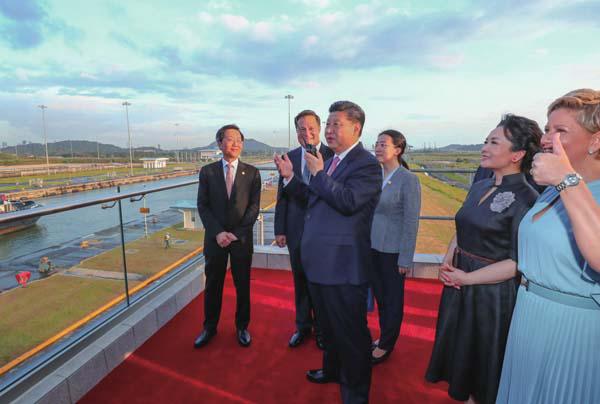Forging Friendship
By Ma Miaomiao

Over 160 years ago, the first group of Chinese workers arrived in Panama to help build the Panama Canal Railway. More arrived starting in 1881 to help construct the actual Panama Canal.
Enrique Lau Cortes, President of the Panama Association of International Studies, is the grandson of one of the canal workers. In addition to being a scholar, Lau has long been committed to promoting China-Panama cultural exchanges, helping to establish a Confucius Institute at the University of Panama.
Like Laus grandfather, many Chinese who contributed to the construction of the railway and canal eventually settled in Panama. With a population of more than 4 million, the country is home to 280,000 Chinese, making it one of the largest Chinese communities in Latin America. According to Lau, overseas Chinese have become part of local communities and have joined the Panamanian people in building the country in pursuit of a better life.
On June 26, 2016, the expanded Panama Canal was inaugurated, and a Chinese container vessel navigated its way through the newly constructed ship locks, making the fi rst historic transit. This year, on December 3, President Xi Jinping paid a visit to the Panama Canal to witness the passage of a fully loaded Chinese container ship through the waterways new locks. Xis trip to Panama, the first after the two countries established diplomatic ties less than two years ago, was an important stop in his European and Latin American tour, during which he also visited Spain, Portugal and Argentina.
Enhanced ties
Infl uenced by the global economic situation, the economic recovery in Latin America remains sluggish, full of uncertainties and vulnerabilities.
Since the beginning of 2018, Argentina and Brazil, affected by an interest rate hike in the United States and a heavy debt burden, have suffered from a currency crisis, triggering turmoil in fi nancial markets. Coupled with the changes in politics, with new leaderships in countries such as Brazil, Mexico, Colombia, Venezuela and Cuba, the economic growth of Latin America is estimated to be only 1.2 percent in 2018, said Sun Yanfeng, Deputy Director of the Institute of Latin American Studies under the China Institutes of Contemporary International Relations (CICIR).
Against the current uncertainties in the region, the enhanced bilateral relations between China on the one hand, and Argentina and Panama, on the other, can play an important role in guiding the future development of relations between China and other Latin American countries and ushering in a new era of stable and long-term China-Latin America relationships, Sun added.
Great trade complementarities lie in China and Latin America, with China now Latin Americas second largest trading partner, its second largest source of imports and third largest export market. More importantly, Latin American countries are all striving to achieve their national development goals by improving infrastructure, expanding exports and promoting reindustrialization. China can be a reliable partner in market and fi nancing support, technology transfer and industrial cooperation.
Xis visit to Argentina and Panama will further promote cooperation between China and Latin American countries and cooperation under the Belt and Road Initiative, said Song Xiaoping, a researcher with the Institute of Latin American Studies under the Chinese Academy of Social Sciences.
Argentinas President Mauricio Macri has taken a positive attitude toward ChineseArgentine relations. In May 2017, as one of the two Latin American leaders who attended the Belt and Road Forum for International Cooperation in Beijing, Macri expressed his countrys willingness to participate in the construction of the Belt and Road.
In 2017, trade between the two countries totaled $13.81 billion, up 12.1 percent year on year, with soybeans, crude oil, meat, seafood, leather and vegetable oil the major commodities imported by China. In the same year, Chinas direct investment in Argentina reached $83.4 million, continuing a steady momentum of growth.
The $5.3 billion China-Argentina hydroelectric mega project, the worlds southernmost and one of the biggest undertaken in the country in the past decade, is also the largest electric power project with investment from Chinese companies. Once completed, it is expected to generate 4.95 billion kilowatt hours of additional electricity for the country, boosting power output by more than 6 percent. The project is also expected to create 5,000 jobs and 15,000 indirect jobs, while driving the socioeconomic development in Santa Cruz Province.
During the second Ministerial Meeting of the Forum of China and the Community of Latin American and Caribbean States(CELAC) in Chile earlier this year, a special joint statement on the China-proposed Belt and Road Initiative was issued. The two sides agreed that the joint construction of the Belt and Road will provide new ideas, inject fresh vitality and explore new prospects for the China-CELAC comprehensive cooperative partnership.
Panama was the first Latin American country to sign a cooperation agreement with China within the framework of the Belt and Road Initiative.
Although Panama established diplomatic ties with China only a year and a half ago, with more than a century of friendly exchanges and large-scale Chinese immigration, Panama is expected to play a greater role in promoting the overall cooperation between China and Latin America by becoming a new and important hub, Lu Yang, another researcher on Latin American studies with CICIR, said.
During his meeting with Panamanian President Juan Carlos Varela, Xi said that the National Logistics Strategy of Panama 2030 and the Belt and Road Initiative are highly compatible, calling on the two sides to synergize their respective development strategies, boost cooperation in areas such as fi nance, tourism, logistics and infrastructure construction, implement key railway, education and healthcare projects, and promote connectivity.
As China now is the second biggest user of the Panama Canal, Xi said the two countries can further optimize consolidated shipment, so that the canal can be more effective in Chinas deeper engagement in global trade.
New impetus
Spain and Portugal have historical ties to Latin America, and China values their influence in the region, Qu Bin, an associate researcher with CICIR, said.
Against the backdrop of Brexit, Spain and Portugal, as European Union (EU) members are playing an increasingly important role within the bloc. Thus, the state visit to Portugal, and earlier to Spain, was of great signifi cance, not only for strengthening bilateral relations, but also for strengthening multilateral relations between China, the EU and Latin America, Qu added.
Portugal lies at an important intersection of the land and maritime silk routes, meaning the two countries are naturally positioned to cooperate under the Belt and Road Initiative. During his talks with Xi, Portuguese President Marcelo Rebelo de Sousa said that his country supports the initiative and is willing to serve as a hub in Europe for the development of the blueprint.
Bilateral trade and investment have seen continuous growth in recent years. In the first 10 months of this year, bilateral trade increased by 8 percent to $5 billion. Chinas imports from Portugal surged 12.5 percent to $1.91 billion. By the end of October, Portugal had invested $210 million in 255 projects in China, while Chinese companies had made about $9 billion worth of investments in Portugal in areas including energy, telecommunication equipment and fi nance.
Businesses in both countries have also achieved success in third-party market cooperation, with energy projects in countries such as Brazil, Chile, Mozambique and Angola a bright spot in bilateral economic ties.
In a signed article published in the Portuguese newspaper Diario de Noticias, Xi called on the two countries to strengthen their blue partnership by facilitating cooperation in marine research, ocean development and protection, port logistics and other areas, and growing the blue economy together to better harness the vast ocean for the benefi t of future generations.
Stating that bilateral ties have stood the test of changes in the international landscape and have developed in a healthy and stable way for the past 39 years when diplomatic ties were established, Xi also said he expects the two countries to expand pragmatic cooperation, enlarge and strengthen existing projects, enhance bilateral trade and create more cooperation aspects for further growth.

